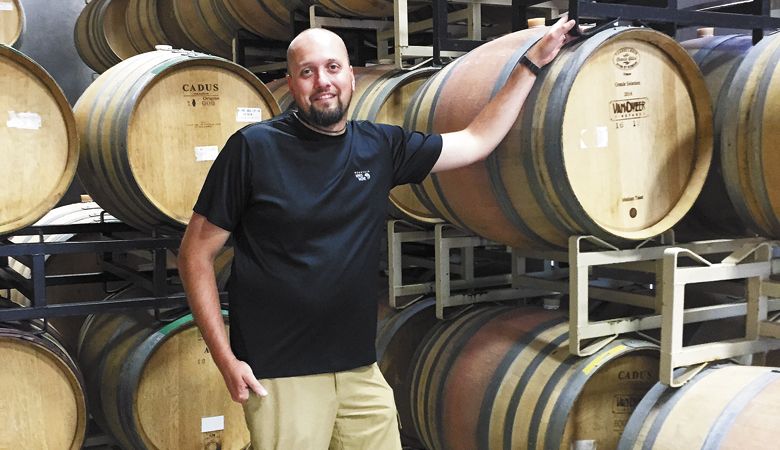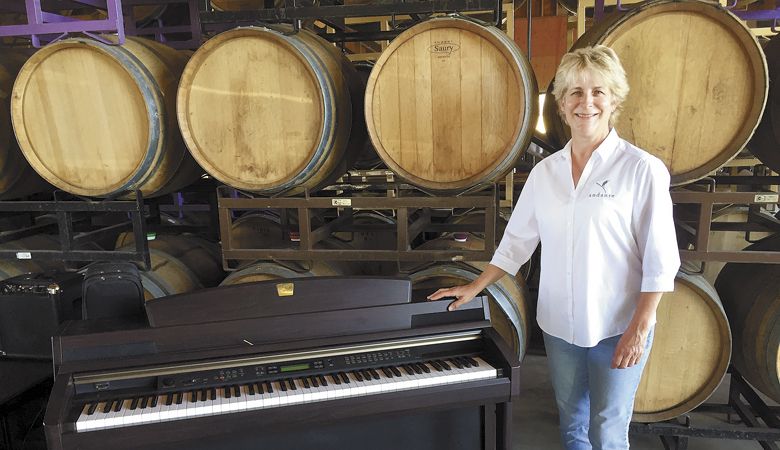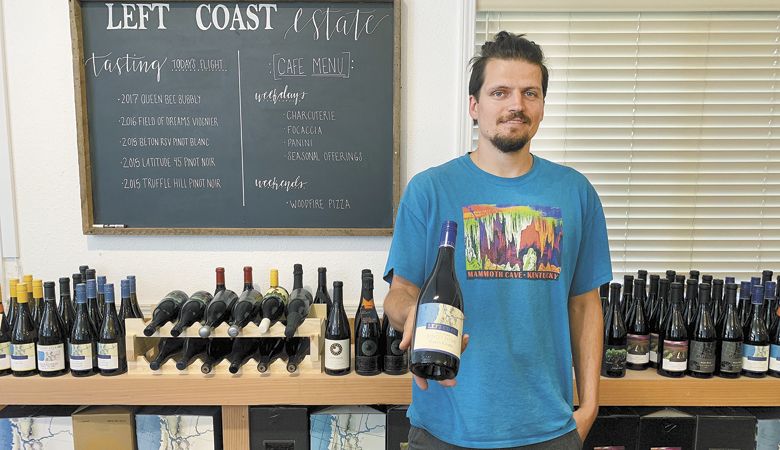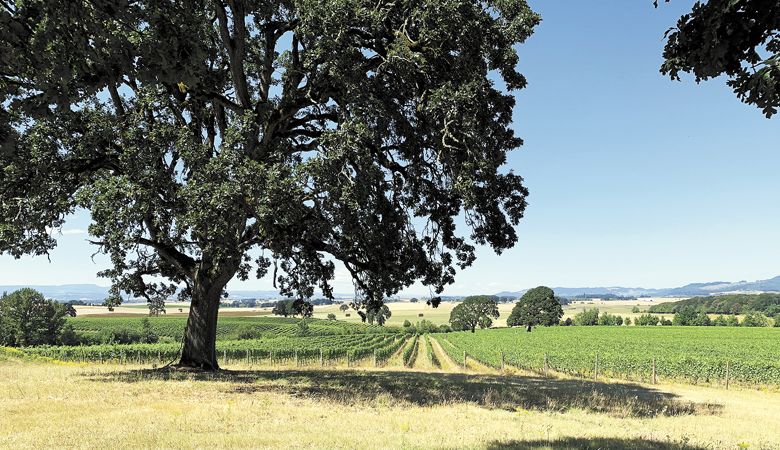Wind in Their Sales
Van Duzer Corridor wineries promote breezy region
Geography is destiny, at least agriculturally speaking. The Van Duzer Corridor, a gap in the Oregon Coast Range, runs from Lincoln City to the Willamette Valley. While pioneers drove their wagons through this passageway many years ago, maritime breezes still flow through it, heading east and rolling over low elevations and vine-laden hills located in the northwestern corner of Polk County. This consistent ocean breeze was the distinguishing factor in the application for the Van Duzer Corridor AVA, approved this January, after eight years of effort.
The wind’s effects are twofold:
First, the afternoon breeze keeps area vineyards cooler than others in the surrounding AVAs, thus the grapes can hang on the vine longer. “We’re usually 10 days, at least, behind the rest of the valley on harvest,” says Taylor Pfaff, CEO of Left Coast Estate in Rickreall. Karen Saul, co-owner of Andante Vineyard in Dallas, adds, “The longer time on the vine allows the fruit to reach desired levels of maturity.” The resulting wines are balanced, fresh, robust in color and flavor, and distinctive from others in the region.
Second, the wind keeps disease pressure down. Florent Merlier, the winemaker at Van Duzer Vineyards, says, “The air flow lowers humidity in the fruiting zone, which reduces the likelihood of fungus. The winds also buffer extreme temperature in either direction throughout the growing season.”
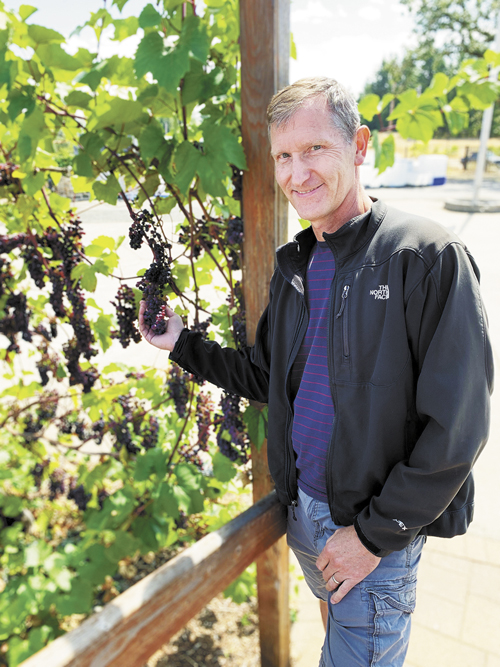
Van Duzer Vineyards, located in Dallas, boasts some of the oldest vines in the area. The Schwarzenberg family planted Chardonnay and Pinot there in 1983. The current owners, Carl and Marilyn Thoma, bought the 110-acre property in 1998. Today, they cultivate 84 planted acres; 30% represent the original vines.
Merlier grew up in Burgundy yet had no interest in winemaking. It wasn’t until his best friend returned from an Oregon internship with some Pinot samples that his interest was piqued. Merlier began assisting at his friend’s family winery and fell in love with the trade.
He worked in Burgundy and attended school at the University of Dijon; next, Merlier worked as a winemaker in Switzerland for six years before moving his family to Oregon in 2009. “Poor timing,” he admits. “I had no idea we were in the middle of a recession.” He worked the 2009 harvest at REX HILL and spent the winter researching and understanding the different nuances of the Willamette Valley in search for an area that suited his winemaking style and intent.
In the summer of 2010, after receiving four job offers, Merlier accepted the assistant winemaker position at Van Duzer. “I really liked this fruit-friendly site,” he explains. “I was intrigued by the potential here and how well-equipped the winery was.” The state-of-the-art facility, built in 2006, has capacity for 20,000 cases. “I saw this as a benefit for myself with more time to make wine.” Merlier advanced to head winemaker in 2013.
And yet, the geography of the site impressed him most, and the buffering of temperatures. He explains, “Our vineyards are cooler while experiencing warm vintages and warmer during cooler vintages, leading to more balanced grapes and wines that showcase ripeness while also preserving lively acidity. This is the hallmark of world-class Pinot Noir.”
The bulk of production represents Pinot Noir, yet whites are also important to the winery. Since Merlier’s time as winemaker, Van Duzer has introduced Pinot Blanc and Chardonnay, the latter being special to him, a tie to his childhood home, Chablis. He places emphasis on highlighting minerality throughout the white wines. Other wines include Riesling, Syrah and rosé.
“Every block and clone has an individual value. I want to produce wine that expresses a sense of place,” Merlier says. The eastern blocks are buffered by the restored oak savanna on higher ground in the middle of the property, while the newer western blocks are most directly exposed to the winds, affording smaller grapes with tougher skin. “This translates to more color, more tannins, more angularity and grain,” he explains.
Andante Vineyard represents the newest winery in the AVA. Joe Allan and Karen Saul, bought the 42-acre property in 2010.
“We had a longing for a place in the country,” says Saul, who grew up in Salem with many relatives in the farming business; Allan was raised in Nevada. When finding a rural address, the couple drew a 30-minute radius around the Salem hospital, as Allan is an ear-nose-and-throat doctor who regularly works the on-call shift.
They initially saw the property on Labor Day weekend in 2009. Although the soil was thin, a winegrower assured them the site would be excellent for grapes. They waffled at first but ultimately made an offer. Two years later, the couple planted their first six acres.
It turns out the thin sedimentary soil — called Chehulpum — sits on top of fractured siltstone and produces delicious fruit. Saul, who started taking classes in Chemeketa Community College’s wine program, left her Portland law practice in 2011 to manage the vineyard and eventual winery.
Planting steadily, Allan and Saul currently maintain 16 acres, with the goal of adding four more. In 2013, they harvested their first crop, selling most of the grapes. Last year was their first crush at their own winemaking facility. “The production facility is five/eighths completed,” she says. “Next, we are planning a tasting room and a bigger barrel room.” For now, they host tastings in the production facility during summer weekends and at Thanksgiving.
Kelly Kidneigh makes the wines for Andante; while her husband, Stirling Fox, manages the vines. Saul says, “We’ve had nothing but positive feedback on our wines,” which include Pinot Noir, Chardonnay, Sauvignon Blanc and rosé. “Our surplus fruit is sold to other wineries, but each year we hope to keep more for our own wine.” Their first vintage bottled at Andante numbered 1,100 cases; they also make wine for several custom-crush customers.
Left Coast Estate is by far the largest property in the AVA at 490 acres of rolling hills with 142 acres of vines. Taylor Pfaff runs the family business and manages day-to-day operations.
His family was living in Colorado when his parents purchased the first 335 acres in 2003. Pfaff says that by the time he was a senior in high school, his parents were at the Left Coast property full time. He worked there in the summer, doing gopher control in high school and grounds-keeping while in college. He credits his summer work with keeping him in the wine industry.
“I really wanted to work a harvest and worked my first in 2011. Since then, I’ve worked harvests and handled a variety of cellar work,” Pfaff says. When administrative help was needed, he stepped in. During that time, he also completed an MBA in wine and spirits. “The program had a very international perspective with 15 of us from 11 different nations,” he explains.
Their first vintage was in 2004. Today, they use almost all their grapes and produce 22,000 cases annually of all estate wine. “For our wine, we want to represent the unique character of our land,” Pfaff says. “Our wines are drastically different from our neighbors’.”
A customer favorite, Left Coast White Pinot Noir offers pristine clarity from limited skin contact. He explains, “We have sold out every vintage since 2011. We started making it when a cold, wet vintage forced us to pick early, but the experiment with under-ripe fruit worked and was an instant hit with our wine club.”
Pfaff continues, “Since we are only 31 miles from the ocean, the maritime wind cools our property overall and impacts day-to-night temperature differences around 20°F on average. The effect is to give our grapes an earthy, nuanced flavor, a very subtle, structured savory note.”
Joe Wright has been Left Coast’s winemaker since 2010. “We shifted the vineyards to him in 2018,” Pfaff says. Two-thirds of the vines are Pinot Noir on marine sediment. “We tried to match clonal Pinot selection to our microclimates with seven varietals and 24 different wines.”
Landscape architect Cali Pfaff, his sister, has contributed to the park-like setting that’s filled with flowers and other plants. “Our vision is for people to go outside and enjoy the setting,” Pfaff says. The 300-year-old white oaks, right outside the tasting room, are part of a long-term preservation project with the Department of Fish and Wildlife that encompasses more than 100 acres. Part of the project involved clearing the invasive understory and planting native seeds.
The tasting room and café are open every day. One of the requirements for the café is serving dishes made from home-grown ingredients, as the property sits on an agricultural preserve. The concept presents some challenges, as does the unpredictability of their customers. “But we’re committed to it; we believe food is an important part of the Left Coast wine experience,” Pfaff says.
Chateau Bianca is the most-western winery in the Van Duzer Corridor, located right off Highway 22, which leads to the coast. Owner/winemaker Andreas Wetzel bought the 87-acre property with his family in 1990; its highest point sits at 750 feet.
Wetzel’s father, Helmut, came from a winemaking family in Germany. He pursued his wine dream in Oregon, partnering with wine pioneer Charles Coury. When Wetzel was fresh out of college, he proposed buying some of his father’s Forest Grove winery. Instead, the partners bought out his father. In turn, Helmut and Andreas bought the Chateau Bianca property, which, at the time, was a government grass furlough project, and the building where the tasting room now stands was a roadside fruit stand.
Chateau Bianca grew slowly over time as the Wetzels reinvested in the business. The first grapes, Pommard and Wädenswil clones of Pinot Noir, were planted on their own roots. At that time, California was in the midst of a major replanting due to a phylloxera outbreak, so they were not able to get any grafted stock to plant. These were the first eight blocks planted on the west side of the property, each measuring between one and two acres, totaling a little more than 12.5 acres.
Since then, all vines have been established using rootstock, which is preferred by LIVE; Chateau Bianca is certified by the organization.
In order to protect these first blocks from phylloxera, Andreas says a seven-foot-high fence surrounding the perimeter of the property keeps the deer away; plus, the site is not contiguous to any other vineyard; they have their own equipment; and all the grapes are handpicked. Further safety measures include the sanitizing of boots, before and after walking in the vines.
The greatest investment early on was the winery. “We started very small, only making wine from our fruit,” Wetzel says. Since then, he has increased the capacity to 45,000 cases with 100,000 gallons of tank space. Why so big? The winery has been a custom-crush facility for 20 years. “This allows us to maximize our equipment and to purchase equipment that’s more current. Although, today there are more equipment options for small and mid-size wineries.”
Chateau Bianca sells three separate brands, once called Wetzel Estate, bearing the family’s coat of arms. Total production measures 10,000 to 12,000 cases a year. At this point in their evolution, the Wetzels might sell some of their grapes but are more likely to purchase fruit. Their hillside property, a frost-free site, generally yields lower amounts because the soil isn’t as deep. He says, “Our premium quality wine is produced from grapes where we pick two to three tons an acre.”
Chateau Bianca proudly retains a full-time crew, year round. ”Wine is not a part-time hobby,” he says. “Our workers have to know what the plant needs at certain times of the year. We babysit our wine until it’s put into the bottle.”
“It’s a luxury we feel is necessary,” continues Wetzel. He is the winemaker, assistant cellar hand and all-around whatever is needed, but during harvest time, he brings in help. Even so, he clocks 18-hour days during crush. “Thinking and planning so far ahead requires mental and physical fortitude.”
Chateau Bianca prides itself on food-friendly wines, balanced with acid and fruit. One of the winery’s more unique offerings is a methode Champenoise rosé, a sparkling made the traditional way, a labor-intensive process that produces the finest bubbles.
Johan Vineyards, located up the road from Left Coast, operates more holistically than its neighbors. When owner Dag Johan Sundby purchased the 175-acre property in 2005, 62 acres had been planted to primarily Pinot Noir, with a small amount of Chardonnay and Pinot Gris.
Since Sundby, a first-generation Norwegian, bought the property for both establishing a vineyard and the family’s new home, he wanted to take special care with the land. Jack Tregenza, who claims many titles, including direct consumer manager, winegrowing assistant and cellar hand, explains, “He was drawn to Biodynamic farming.”
Sundby hired Dan Rinke as winegrower to transition the property to Biodynamic farming, achieving that certification in 2010. “Still, it took nearly six years to complete the transformation, to re-establish the vineyard after pulling the plug on chemicals,” Tregenza says. Among other factors, Biodynamics aims to improve nutrient quality. “The goal is to create a whole farm individuality,” he adds.
“Biodynamics tells us what to do,” Tregenza says. “In the vineyard, we use horsetail and willow tea, compost tea and other historic options rather than fungicides. One of the biggest focuses is building the soil, treating it as a living medium and enhancing microbial growth.” Irrigation was used solely for vine establishment, and all of the canopy management is by hand.
The farm encompasses nearly 40 acres of oak savanna and riparian areas with numerous species of native plants.
Inside the winery, Johan produces 5,000 to 6,000 cases annually, with an aim to increase each year. They market half the grapes from 87 acres. “We sell to about 20 different producers, and we’re selective in who we sell to. Generally, we prefer wineries that make single-vineyard designate wines,” he says. For example, they grow Cabernet Franc exclusively for Bow & Arrow Wines in Portland.
Tregenza’s interest in wine started in Rhode Island, where he worked in fine dining as a sommelier. From there, he traveled to New Zealand to study viticulture and enology at Lincoln University. He worked at Holloran Vineyard Wines in the Dundee Hills for a few years before joining the crew at Johan.
He sees firsthand the cooling effect of the Van Duzer winds on the fruit and resulting wine. “Stylistically, the wines from our AVA are very different from others in the Valley. The effect of the marine winds is crucial as our growing seasons become hotter and hotter,” Tregenza says. The Salt Creek also makes an impact. “We see a level of salinity in all our wines due to the salt in the water table. We try to highlight that minerality in our wines.”
Johan’s winegrower started diversifying clonal selections to move away from the early-ripening Dijon clones and to farm for flavor. Then he began adding other varieties, such as Grüner Veltliner, an Austrian-style white, and Blaufränkisch, a red Austrian grape that retains acidity.
“These are new varieties for Oregon,” Tregenza explains. “We have 16 now and continue to add more. We see these as good alternatives moving forward in less and less typical growing seasons. A big part of the overall thought process is to make wine in the context of the world. We want to expand what Oregon is supposed to taste like.”
Holmes Gap Vineyard, owned by Jack and Cheri La Rue, sells 90% of their grapes. “We bought the 165-acre property in 2001, moved here full time in 2004 and planted our first vineyard in 2006,” says Jack. The vineyard now includes 12 acres of Pinot and Chardonnay; the goal is 25 acres total.
Like many of his neighbors, La Rue’s property contains large stands of white oak under restoration. “This area of rolling hills, oaks and large fields reminds me of the winegrowing regions of France,” he says. “We really enjoy the immediate payback of the vineyard and seeing what you’re able to do.”
The couple produces about 400 to 600 cases of Pinot Noir, available at pop-up tastings and online. When asked about this year’s harvest, “We’re usually one of the last vineyards to bring in grapes,” he says, in reference to the coolness of the AVA.
Namasté Vineyards claims the oldest vines in the AVA, 22.8 acres planted in 1980. Dave Masciorini bought the 200-acre property in 2000; his first vintage was 2002.
He makes his wine at Chateau Bianca, and his annual production stands at 1,000 to 1,500 cases. Peace, his popular award-winning white blend, is made from estate Chardonnay, Riesling and Gewürztraminer. Masciorini also grows Dijon 115 and Pommard clone Pinot Noir.
Namasté boasts two tasting rooms, one on the property; the other 12 miles away on Highway 99W.
Jeff Havlin of Havlin Vineyard was instrumental in getting the new AVA established. He sells most of the fruit from his 37 acres of producing vines and keeps some for his own label, which is made by a colleague.
Please note: Firesteed tasting room will be moving from its current location at the winery in the Van Duzer Corridor to a new location in the Dundee Hills AVA.


